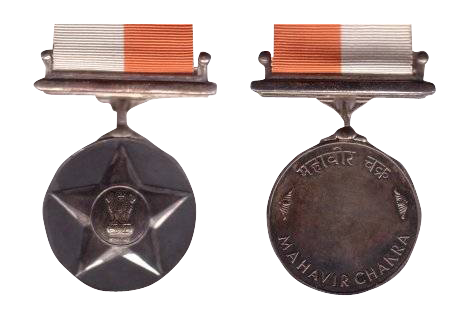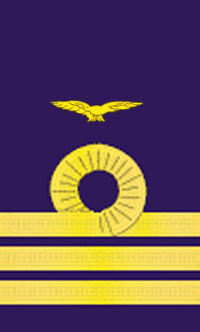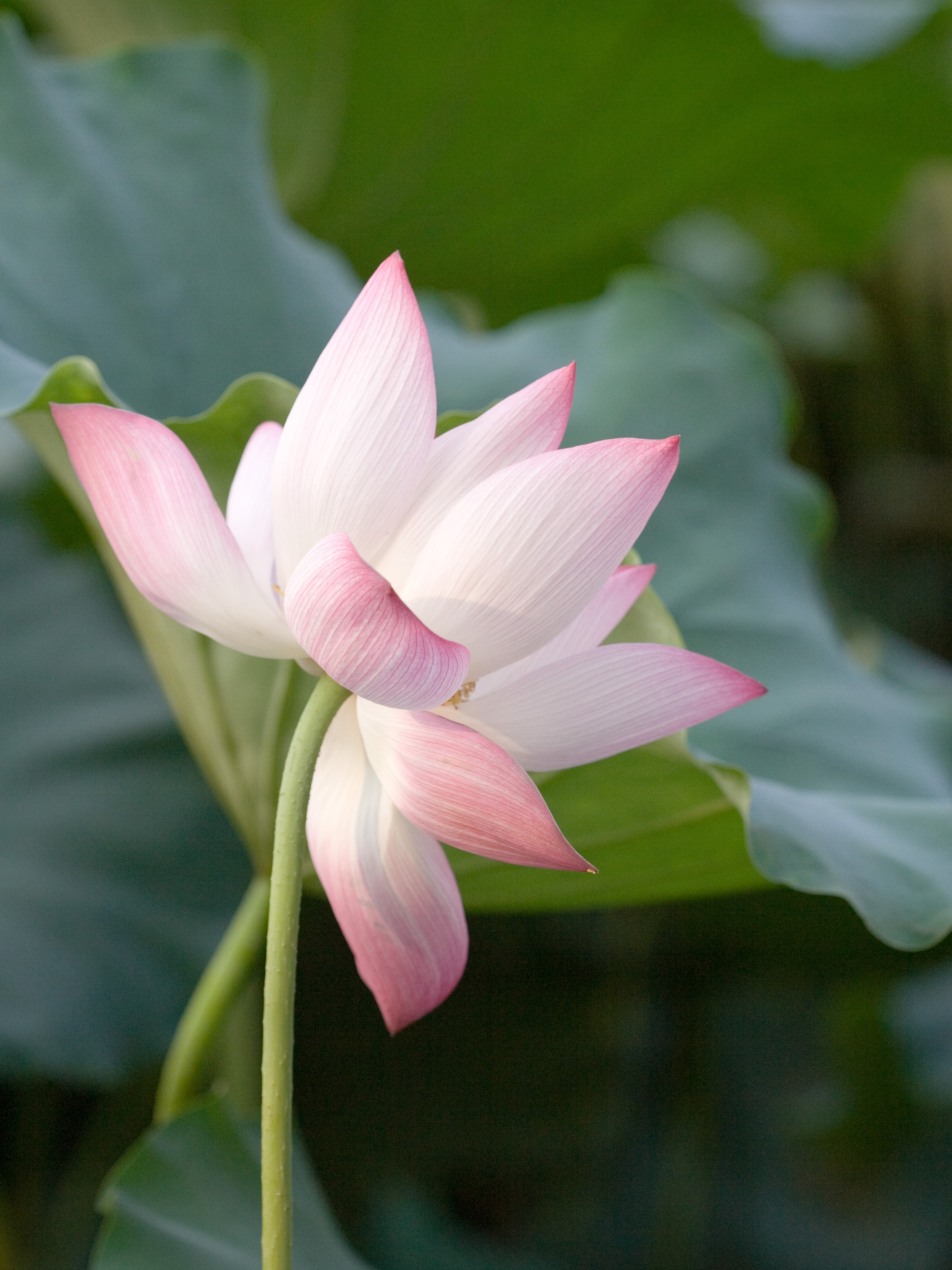|
Maha Vir Chakra
The Maha Vir Chakra (MVC) () is the second highest military decoration in India, after the Param Vir Chakra, and is awarded for acts of conspicuous gallantry in the presence of the enemy, whether on land, at sea or in the air. It replaced the British Distinguished Service Order (DSO). The medal may be awarded posthumously. Appearance The medal is made of standard silver and is circular in shape. Embossed on the obverse is a five pointed heraldic star with circular center-piece bearing the gilded state emblem of India in the center. The words "Mahavira Chakra" are embossed in Hindi and English on the reverse with two lotus flowers in the middle. The decoration is worn on the left chest with a half-white and half-orange riband about 3.2 cm in width, the orange being near the left shoulder. History More than 218 acts of bravery and selfless courage have been recognized since the inception of the medal. The most MVCs awarded in a single conflict was in the Indo-Pak ... [...More Info...] [...Related Items...] OR: [Wikipedia] [Google] [Baidu] |
Rajinder Singh Sparrow
Major General Rajinder Singh, MVC & bar (3 October 1911 – May 1994) was an Indian Army officer and a two time member of the Lok Sabha, the lower house of the Indian parliament. He was nicknamed 'Sparrow'. Career Singh served in the ranks of the British Indian Army from 3 October 1932 to 31 January 1938. He attended the Indian Military Academy, Dehra Dun, and was commissioned onto the Unattached List, Indian Army on 1 February 1938. He spent the next year attached to The King's Regiment (Liverpool), a British Army regiment, stationed on the North West Frontier. He was then admitted to the Indian Army and joined the 7th Light Cavalry on 24 February 1939. He was promoted to lieutenant on 30 April 1939, and served during World War II. He was promoted temporary captain and acting major on 16 April 1942, to war-substantive captain and temporary major on 9 January 1943 and to substantive captain on 31 January 1945. Singh opted to join the Indian Army upon the partition of India i ... [...More Info...] [...Related Items...] OR: [Wikipedia] [Google] [Baidu] |
Jag Mohan Nath
Wing Commander Jag Mohan Nath , was an Indian Air Force officer . He is the first of the six officers to have been decorated with the Maha Vir Chakra, India's second highest war time military decoration, twice. He was decorated for his operations in the Sino-Indian War of 1962 and Indo-Pakistani War of 1965. Early life Jag Mohan Nath was born in Jaipur then grew in Layyah, Punjab, British India (now in Pakistan) in a Punjabi Hindu family of doctors. He served in the Air Force from 1948 to 1969, before taking up a position in Air India. Military career He joined the Air Force Administrative College in Coimbatore in 1948. He was first awarded the Maha Vir Chakra for his role in reconnaissance missions in Aksai Chin and Tibet, before and during the 1962 war. His missions proved useful in learning about the Chinese military build-up in Aksai Chin. He flew around 30 reconnaissance missions into Pakistan during the 1965 war in an English Electric Canberra, which earned him his second ... [...More Info...] [...Related Items...] OR: [Wikipedia] [Google] [Baidu] |
Param Vishisht Seva Medal
Param Vishisht Seva Medal (PVSM) ( IAST: ) is a military award of India. It was constituted in 1960 and since then it is awarded in recognition to peace-time service of the most exceptional order and may be awarded posthumously. All ranks of the Indian Armed Forces including Territorial Army, Auxiliary and Reserve Forces, Nursing officers and other members of the Nursing services and other lawfully constituted Armed Forces are eligible for the award. History The Param Vishisht Seva Medal was originally instituted as the "Vishisht Seva Medal, Class I" on 26 January 1960. Five other medals were instituted on the same day: the Sainya Seva Medal, Sena Medal, Nao Sena Medal Nau Sena Medal (also spelt ''Nao Sena Medal'', lit. ''Navy Medal'') is a gallantry award for servicemen in the Indian Navy. History The Nao Sena Medal was instituted on 26 January 1960 by the Government of India, with the approval of the Presid ... and the Vayu Sena Medal. It was renamed on January 27, 1961, ... [...More Info...] [...Related Items...] OR: [Wikipedia] [Google] [Baidu] |
Obverse
Obverse and its opposite, reverse, refer to the two flat faces of coins and some other two-sided objects, including paper money, flags, seals, medals, drawings, old master prints and other works of art, and printed fabrics. In this usage, ''obverse'' means the front face of the object and ''reverse'' means the back face. The obverse of a coin is commonly called ''heads'', because it often depicts the head of a prominent person, and the reverse ''tails''. In numismatics, the abbreviation ''obv.'' is used for ''obverse'',David Sear. ''Greek Imperial Coins and Their Values.'' Spink Books, 1982. p. xxxv. while ℞, )(Jonathan Edwards. ''Catalogue of the Greek and Roman Coins in the Numismatic Collection of Yale College, Volume 2.'' Tuttle, Morehouse & Taylor, 1880. p. 228. and rev.Allen G. Berman. ''Warman's Coins And Paper Money: Identification and Price Guide.'' Penguin, 2008. are used for reverse. In fields of scholarship outside numismatics, the term ''front'' is more ... [...More Info...] [...Related Items...] OR: [Wikipedia] [Google] [Baidu] |
Major General (India)
Major general is a two-star general officer rank in the Indian Army. It is the third-highest active rank in the Indian Army. A major general ranks above the one-star rank of brigadier and below the three-star rank of lieutenant general. The equivalent rank in the Indian Navy is rear admiral and in the Indian Air Force is air vice marshal. Appointments Officers in the rank of major general hold important appointments like general officer commanding a division. The Indian Army has 40 divisions in 14 corps. The general officers commanding sub areas across the country are also of the rank of major general. At army headquarters, major generals hold the appointments of additional director general in different directorates and staff branches. Insignia The badges of rank have a crossed sword and baton and a five-pointed star above. A major general wears gorget patches which are crimson patches with two golden stars. Order of precedence A major general who is a principal staff office ... [...More Info...] [...Related Items...] OR: [Wikipedia] [Google] [Baidu] |
Wing Commander (rank)
Wing commander (Wg Cdr in the RAF, the IAF, and the PAF, WGCDR in the RNZAF and RAAF, formerly sometimes W/C in all services) is a senior commissioned rank in the British Royal Air Force and air forces of many countries which have historical British influence, including many Commonwealth countries but not including Canada (since Unification) and South Africa. It is sometimes used as the English translation of an equivalent rank in countries which have a non-English air force-specific rank structure. It ranks immediately above squadron leader and immediately below group captain. It has a NATO ranking code of OF-4. It is equivalent to commander in the Royal and United States Navies, as well as to lieutenant colonel in the British Army, the Royal Marines, and the United States Army, Air Force and Marine Corps. The equivalent rank in the Women's Auxiliary Air Force and the Women's Royal Air Force (until 1968) and in Princess Mary's Royal Air Force Nursing Service (unti ... [...More Info...] [...Related Items...] OR: [Wikipedia] [Google] [Baidu] |
Indian Air Force
The Indian Air Force (IAF) is the air arm of the Indian Armed Forces. Its complement of personnel and aircraft assets ranks third amongst the air forces of the world. Its primary mission is to secure Indian airspace and to conduct aerial warfare during armed conflict. It was officially established on 8 October 1932 as an auxiliary air force of the British Empire which honoured India's aviation service during World War II with the prefix ''Royal''. After India gained independence from United Kingdom in 1947, the name Royal Indian Air Force was kept and served in the name of Dominion of India. With the government's transition to a Republic in 1950, the prefix ''Royal'' was removed. Since 1950, the IAF has been involved in four wars with neighbouring Pakistan. Other major operations undertaken by the IAF include Operation Vijay, Operation Meghdoot, Operation Cactus and Operation Poomalai. The IAF's mission expands beyond engagement with hostile forces, with the IAF partic ... [...More Info...] [...Related Items...] OR: [Wikipedia] [Google] [Baidu] |
Indo-Pakistani War Of 1971
The Indo-Pakistani War of 1971 was a military confrontation between India and Pakistan that occurred during the Bangladesh Liberation War in East Pakistan from 3 December 1971 until the Pakistani capitulation in Dhaka on 16 December 1971. The war began with Pakistan's Operation Chengiz Khan, consisting of preemptive aerial strikes on 11 Indian air stations. The strikes led to India declaring war on Pakistan, marking their entry into the war for East Pakistan's independence, on the side of Bengali nationalist forces. India's entry expanded the existing conflict with Indian and Pakistani forces engaging on both the eastern and western fronts. Thirteen days after the war started, India achieved a clear upper hand, and the Eastern Command of the Pakistan military signed the instrument of surrender on 16 December 1971 in Dhaka, marking the formation of East Pakistan as the new nation of Bangladesh. Approximately 93,000 Pakistani servicemen were taken prisoner ... [...More Info...] [...Related Items...] OR: [Wikipedia] [Google] [Baidu] |
Shoulder
The human shoulder is made up of three bones: the clavicle (collarbone), the scapula (shoulder blade), and the humerus (upper arm bone) as well as associated muscles, ligaments and tendons. The articulations between the bones of the shoulder make up the shoulder joints. The shoulder joint, also known as the glenohumeral joint, is the major joint of the shoulder, but can more broadly include the acromioclavicular joint. In human anatomy, the shoulder joint comprises the part of the body where the humerus attaches to the scapula, and the head sits in the glenoid cavity. The shoulder is the group of structures in the region of the joint. The shoulder joint is the main joint of the shoulder. It is a ball and socket joint that allows the arm to rotate in a circular fashion or to hinge out and up away from the body. The joint capsule is a soft tissue envelope that encircles the glenohumeral joint and attaches to the scapula, humerus, and head of the biceps. It is lined by a ... [...More Info...] [...Related Items...] OR: [Wikipedia] [Google] [Baidu] |
Ribbon
A ribbon or riband is a thin band of material, typically cloth but also plastic or sometimes metal, used primarily as decorative binding and tying. Cloth ribbons are made of natural materials such as silk, cotton, and jute and of synthetic materials, such as polyester, nylon, and polypropylene. Ribbon is used for useful, ornamental, and symbolic purposes. Cultures around the world use ribbon in their hair, around the body, and as ornament on non-human animals, buildings, and packaging. Some popular fabrics used to make ribbons are satin, organza, sheer, silk, velvet, and grosgrain. Etymology The word ribbon comes from Middle English ''ribban'' or ''riban'' from Old French ''ruban'', which is probably of Germanic origin. Cloth Along with that of tapes, fringes, and other smallwares, the manufacture of cloth ribbons forms a special department of the textile industries. The essential feature of a ribbon loom is the simultaneous weaving in one loom frame of two or more webs, g ... [...More Info...] [...Related Items...] OR: [Wikipedia] [Google] [Baidu] |
Chest
The thorax or chest is a part of the anatomy of humans, mammals, and other tetrapod animals located between the neck and the abdomen. In insects, crustaceans, and the extinct trilobites, the thorax is one of the three main divisions of the creature's body, each of which is in turn composed of multiple segments. The human thorax includes the thoracic cavity and the thoracic wall. It contains organs including the heart, lungs, and thymus gland, as well as muscles and various other internal structures. Many diseases may affect the chest, and one of the most common symptoms is chest pain. Etymology The word thorax comes from the Greek θώραξ ''thorax'' " breastplate, cuirass, corslet" via la, thorax. Plural: ''thoraces'' or ''thoraxes''. Human thorax Structure In humans and other hominids, the thorax is the chest region of the body between the neck and the abdomen, along with its internal organs and other contents. It is mostly protected and supported by the rib cage, spin ... [...More Info...] [...Related Items...] OR: [Wikipedia] [Google] [Baidu] |
Indian Lotus
''Nelumbo nucifera'', also known as sacred lotus, Laxmi lotus, Indian lotus, or simply lotus, is one of two extant species of aquatic plant in the family Nelumbonaceae. It is sometimes colloquially called a water lily, though this more often refers to members of the family Nymphaeaceae. Lotus plants are adapted to grow in the flood plains of slow-moving rivers and delta areas. Stands of lotus drop hundreds of thousands of seeds every year to the bottom of the pond. While some sprout immediately, and most are eaten by wildlife, the remaining seeds can remain dormant for an extensive period of time as the pond silts in and dries out. During flood conditions, sediments containing these seeds are broken open, and the dormant seeds rehydrate and begin a new lotus colony. Under favorable circumstances, the seeds of this aquatic perennial may remain viable for many years, with the oldest recorded lotus germination being from seeds 1,300 years old recovered from a dry lakebed in no ... [...More Info...] [...Related Items...] OR: [Wikipedia] [Google] [Baidu] |








